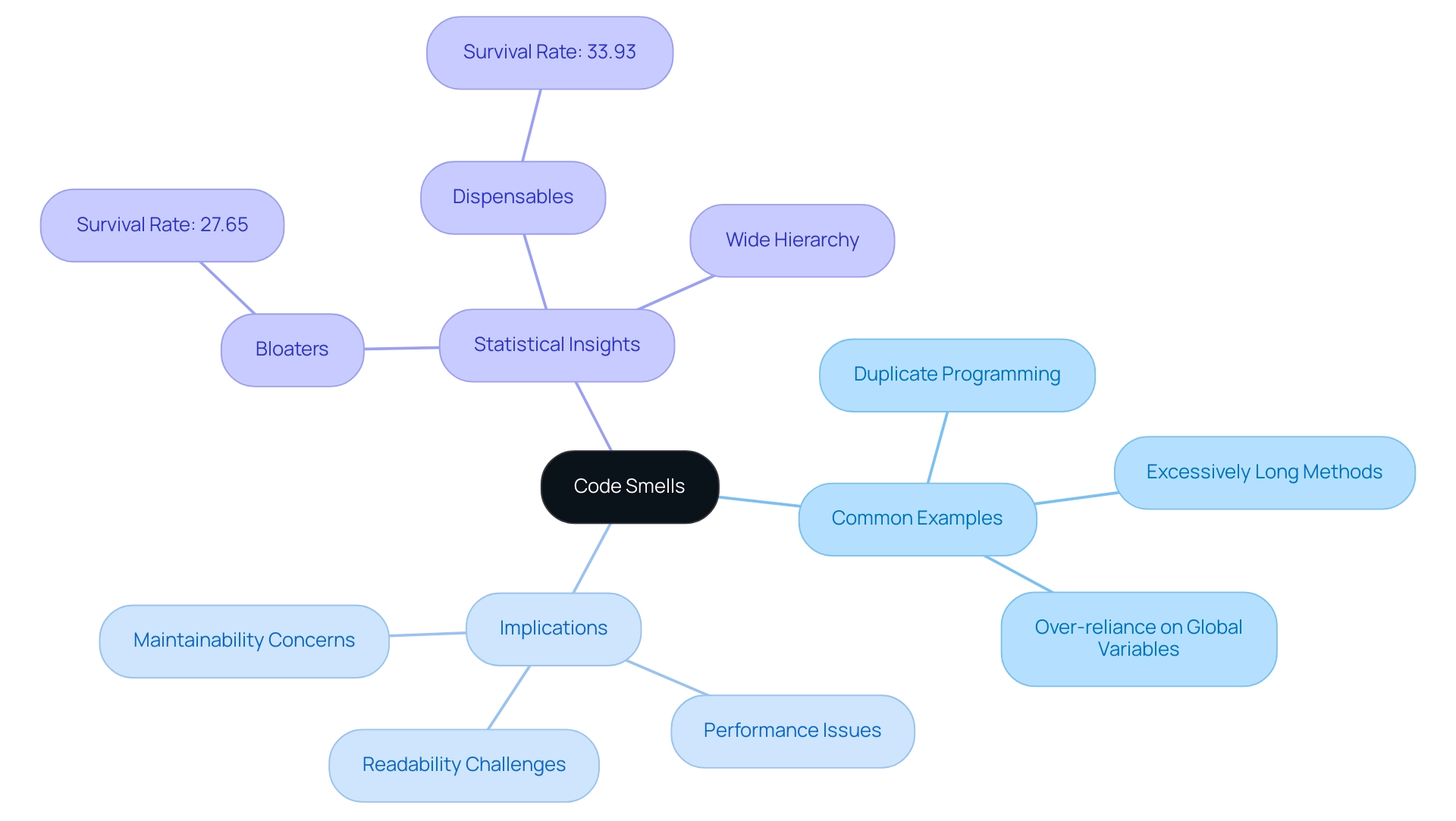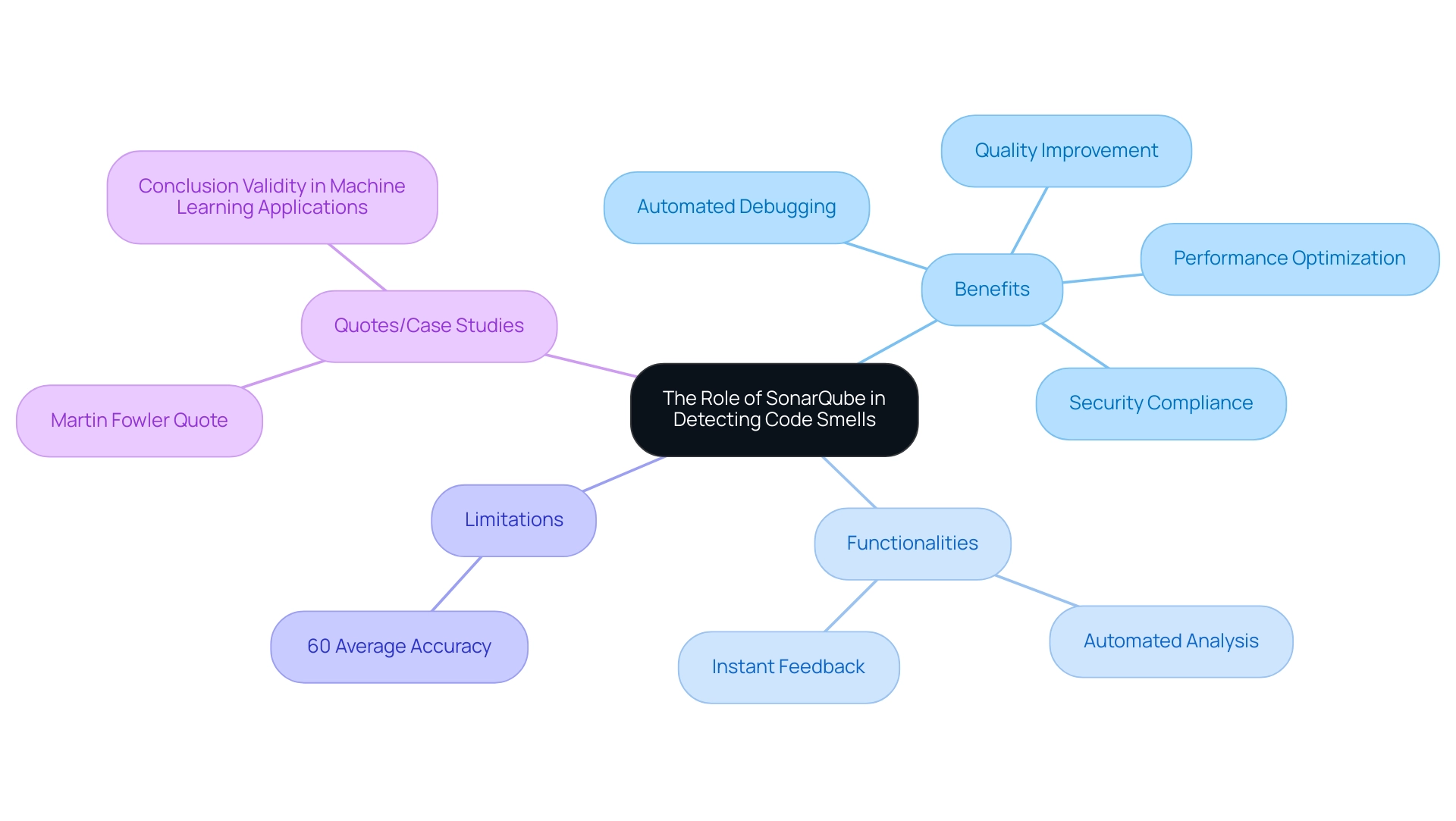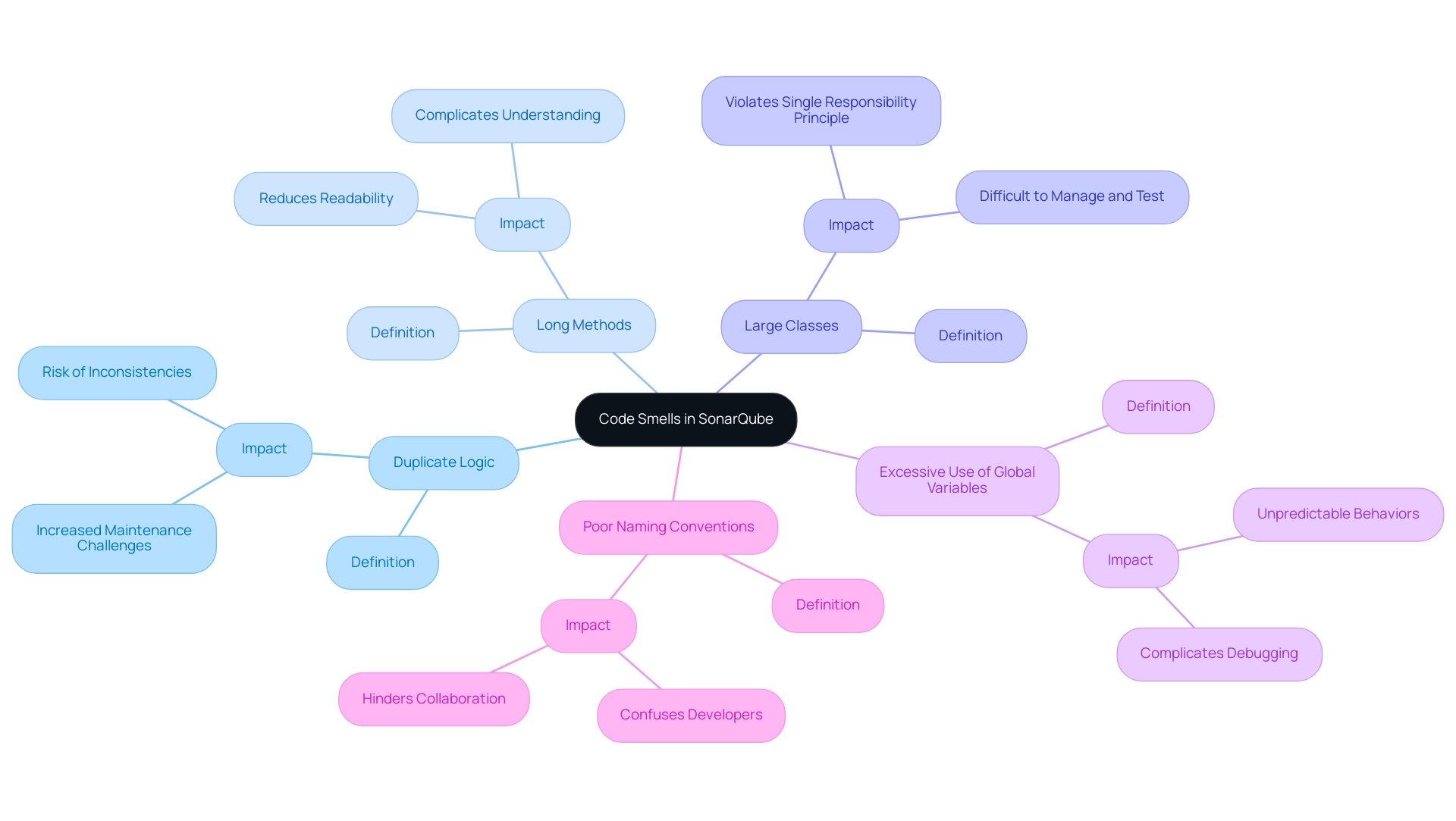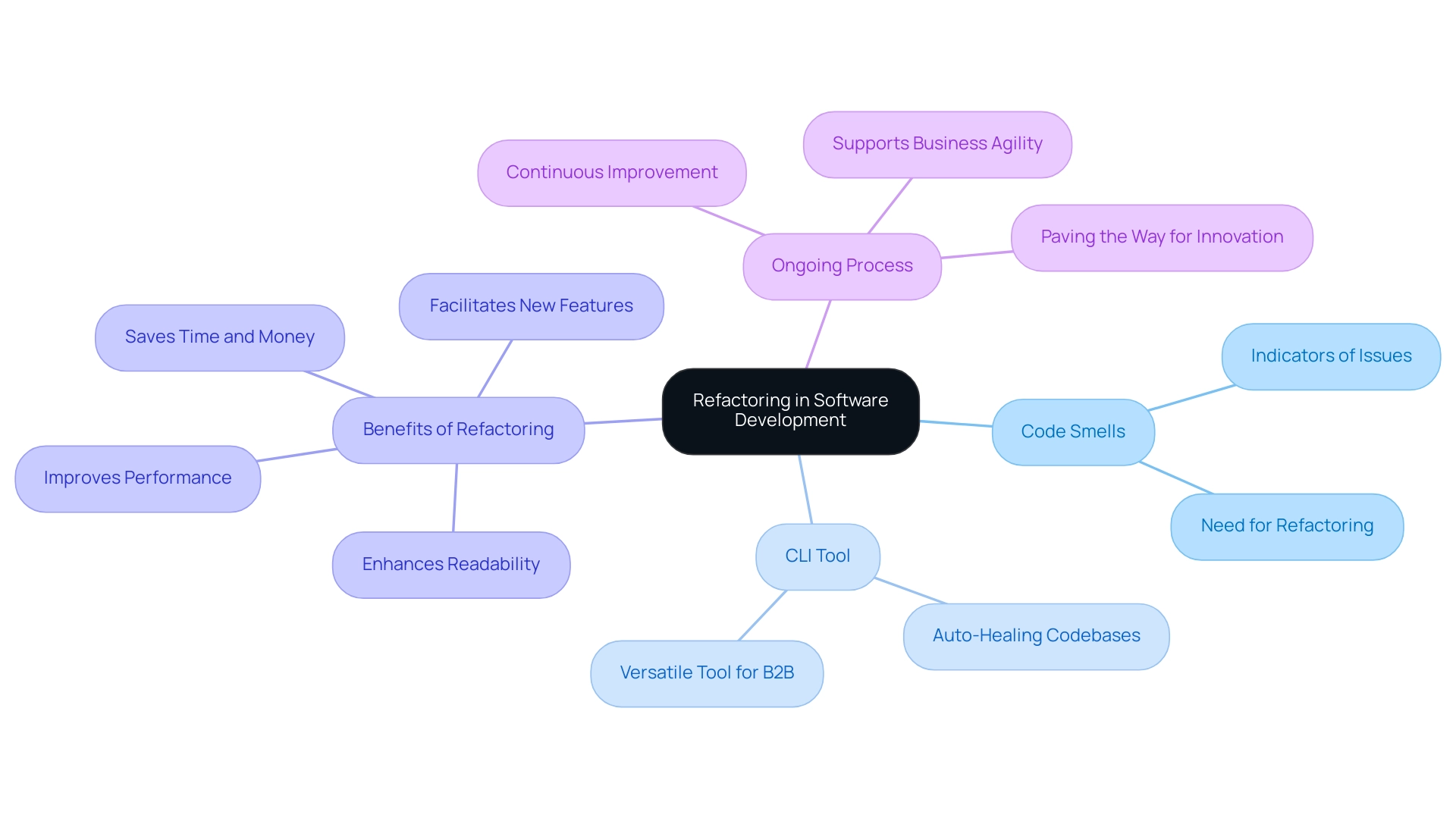Introduction
In the realm of software development, maintaining a clean and efficient codebase is paramount for success. Code smells—subtle indicators of underlying issues—can silently undermine performance, readability, and maintainability if left unchecked. By harnessing tools like Kodezi CLI and SonarQube, developers can proactively identify and address these potential pitfalls, transforming their coding practices and enhancing overall productivity.
The journey to a robust codebase begins with understanding these code smells, recognizing their implications, and implementing effective strategies for prevention and refactoring. This article delves into the significance of code smells, the tools available for detection, and best practices for fostering a healthier development environment, ensuring teams can navigate the complexities of coding with confidence and efficiency.
Defining Code Smells: An Overview
Code indicators are signs within a codebase that highlight potential weaknesses or issues, which can be understood as what is code smell in SonarQube. While they may not directly present as bugs, if left unaddressed, they can lead to significant problems. Common examples include:
- Duplicate programming
- Excessively long methods
- Over-reliance on global variables
Identifying what is code smell in SonarQube is essential for preserving , as these programming flaws frequently indicate deeper underlying problems that can undermine performance, readability, and maintainability. Kodezi CLI acts as a flexible instrument for engineering teams, independently identifying and resolving before they develop into more serious complications. According to Nicolas Cardozo from Universidad los Andes, the most frequent issues identified are lengthy methods and extensive method chains, emphasizing challenges in the definition and interaction of agents.
Remarkably, recent research indicates that most design flaws are introduced at the inception of a new class, challenging the notion that they accumulate over time. Additionally, statistics show that Bloaters and Dispensables have around 27.65% and 33.93% chance of survival respectively at the end of the observation period, emphasizing their persistence in codebases. The idea of Wide Hierarchy, which pertains to inheritance hierarchies with numerous sub-types at the same level, further demonstrates the potential issues that arise from programming flaws.
By recognizing programming issues early with the CLI tool, developers can reduce the likelihood of more serious problems, ultimately improving software quality and overall efficiency. A case study titled 'Survivability Analysis' emphasizes how the Kaplan-Meier Estimator can be utilized to determine the likelihood of survival for each kind of issue, offering insights into their persistence during software development. To get started, check out our 5 minute quickstart and see a demo to experience how Kodezi CLI can enhance your coding practices.

The Role of SonarQube in Detecting Code Smells
SonarQube stands out as a robust tool that automates analysis, enabling developers to identify issues with precision while integrating automated debugging capabilities that facilitate rapid resolution. By seamlessly incorporating SonarQube into their development workflow, teams gain instant feedback on quality, allowing them to pinpoint and rectify potential issues early in the development process. This integration not only improves quality but also optimizes performance and ensures security compliance by following the latest security best practices and programming standards.
Utilizing a comprehensive set of predefined rules, SonarQube meticulously examines programming, providing detailed explanations and insights into what went wrong and how it was resolved, thereby emphasizing what is code smell in SonarQube and the areas requiring attention. This proactive approach is crucial for teams devoted to upholding high standards in both quality and performance. While it is important to note that SonarQube metrics presented the lowest accuracy at 60% on average, highlighting its limitations in bug prediction, the value of automated debugging cannot be overstated.
As Martin Fowler aptly states, 'Smells are not inherently bad in their own - they are often an indicator of a problem rather than the problem themselves.' This perspective underscores the need for further evaluation of like SonarQube, particularly regarding the grouping of rule types and their impact on model performance. Additionally, the case study titled 'Conclusion Validity in Machine Learning Applications' emphasizes the necessity of cross-project validation and acknowledges that other statistical or machine learning techniques could yield different results.
As teams strive for excellence in software development, leveraging SonarQube not only enhances quality through automated debugging but also significantly boosts overall productivity.

Common Types of Code Smells Identified by SonarQube
SonarQube effectively identifies prevalent issues, such as what is code smell in SonarQube, which can significantly hinder software quality and maintainability. These include:
- Duplicate Logic: The repeated presence of identical logic in various locations can lead to increased maintenance challenges and the risk of introducing inconsistencies.
- Long Methods: Excessively lengthy methods complicate understanding and maintenance, potentially obscuring logic and reducing overall readability.
- Large Classes: Classes burdened with too many responsibilities violate the Single Responsibility Principle, making them difficult to manage and test.
- Excessive Use of Global Variables: Over-reliance on global variables can result in unpredictable behaviors, complicating debugging efforts and reducing clarity.
- Poor Naming Conventions: Inaccurate or ambiguous naming of variables and methods can confuse developers and hinder collaboration.
Identifying what is code smell in SonarQube is essential for teams looking to restructure their work and improve overall quality. Addressing these issues not only streamlines maintenance but also promotes good coding practices, ultimately leading to improved software performance and reliability. Statistics indicate that numerous development teams encounter what is code smell in SonarQube, with a substantial share of projects noting occurrences of these common programming elements—emphasizing the necessity for proactive management.
For practical reference, is accessible at localhost:9000, providing teams with a direct tool for monitoring and addressing these issues. As Aditya Roshan, a Technical Leader, states, "Unleash data intelligence and e-commerce. Join me, an experienced Technical Leader, to explore insights and strategies for success.
Let's revolutionize together." This expert perspective highlights the significance of addressing programming issues in the quest for efficient and high-quality software development. Additionally, a notable case study illustrates the real-world implications: a product owner noticed that the Sonar dashboard displayed 'A' ratings for Bugs, Vulnerabilities, and Debt, yet found numerous unresolved issues related to what is code smell in SonarQube upon checking.
This emphasizes the essential requirement for teams to tackle programming issues proactively to ensure overall software quality. By tackling these programming smells head-on, teams can unleash the potential of their codebase and drive greater efficiency in their development processes.

The Importance of Refactoring to Address Code Smells
Refactoring is a crucial practice in software development that emphasizes reorganizing existing structures while maintaining their external functionality. By addressing what is code smell in SonarQube—indicators of potential issues in the codebase—developers can significantly enhance readability, maintainability, and overall performance. Utilizing the CLI, a versatile tool for B2B engineering teams and often referred to as the 'Swiss-Army Knife for programmers,' allows for auto-healing codebases in seconds, which complements effective refactoring.
This leads to the elimination of redundancies, simplification of complex methods, and adherence to established coding standards, resulting in a more efficient and robust codebase. Furthermore, the CLI streamlines the coding process and saves development teams both time and money, facilitating quicker implementation of new features. Statistics indicate that refactoring, particularly when aided by the CLI, can result in substantial performance enhancements, further highlighting its worth.
In the words of Muzammil K., Marketing Manager at Aalpha Information Systems,
A commitment to results in the ever-changing digital landscape is crucial for success.
This perspective emphasizes the significance of seeing refactoring, along with the use of tools, as an ongoing process that promotes business agility and innovation. The case study titled 'Final Insights' illustrates that code refactoring should be viewed as an ongoing investment that supports business agility and growth, paving the way for innovation and scalability.
Regularly engaging in refactoring with the support of digital tools ensures that can adapt seamlessly to evolving requirements, solidifying its role as a fundamental practice for long-term success in software development. To get started, check out the '5 minute quickstart' or 'see a demo' to experience how the CLI can transform your coding practices.

Best Practices for Preventing Code Smells in Development
To effectively prevent code smells and enhance the quality of your codebase, developers should implement the following best practices, leveraging tools like Kodezi CLI, the B2B Swiss Army Knife for Engineering Teams, to maximize efficiency:
- Adhere to Coding Standards: Establishing and adhering to clear coding conventions is crucial for maintaining consistency and readability across the codebase, facilitating easier collaboration among team members. Kodezi CLI can assist in automating compliance with these standards, ensuring that your codebase remains clean and organized. According to Yang, J. et al. (2015), a classification model for software clones can significantly improve adherence to programming standards, thereby enhancing quality.
- : Regular peer reviews are essential for early identification of potential issues, significantly reducing the risk of programming flaws developing in the first place. The CLI can offer independent analysis during these reviews, assisting in prioritizing quality issues through systematic evaluations, as noted by Cerny, T. (2022).
- Write Unit Tests: Implementing comprehensive unit tests aids in detecting problems before they become entrenched within the code, thereby promoting a healthier codebase. The CLI can streamline the creation and execution of these tests, ensuring thorough coverage and quicker feedback.
- Keep Methods Short and Focused: Strive for methods that accomplish a single task. This practice not only enhances clarity but also improves maintainability, and the CLI can help refactor lengthy methods into simpler, more manageable components.
- Use Meaningful Names: Selecting descriptive names for variables and methods is vital. Clear naming conventions convey the purpose of each element, improving understanding for anyone interacting with the script. The CLI can recommend naming conventions based on best practices, improving readability.
A practical example of these best practices can be seen in the case study titled "Merging Code Smells with Heat Map." This study demonstrates how combining defect detection outcomes with heatmap graphs enables the visualization of business processes alongside quality metrics, serving as a foundation for prioritizing optimization efforts.
By integrating these practices into the development process and utilizing the CLI, teams can create a cleaner and more efficient codebase, significantly reducing the likelihood of encountering what is code smell in SonarQube, thereby enhancing overall productivity. For those interested in getting started quickly, check out the 5 minute quickstart and see a demo to explore Kodezi CLI's capabilities.
Conclusion
Maintaining a clean and efficient codebase is crucial for the success of any software development project. Code smells serve as indicators of potential weaknesses that, if ignored, can lead to significant issues affecting performance, readability, and maintainability. By utilizing tools like Kodezi CLI and SonarQube, developers can proactively identify and address these code smells, fostering a healthier development environment.
The integration of Kodezi CLI and SonarQube into the coding workflow not only enhances the detection of common code smells but also streamlines the refactoring process. With Kodezi CLI’s ability to automate repairs and SonarQube’s comprehensive analysis capabilities, teams can significantly improve code quality and efficiency. Furthermore, implementing best practices such as:
- Adhering to coding standards
- Conducting regular code reviews
- Writing unit tests
will help prevent code smells from arising in the first place.
In conclusion, the journey to a robust codebase is one of continuous improvement and vigilance. By recognizing the significance of code smells and leveraging the right tools and practices, development teams can enhance their productivity, reduce technical debt, and ultimately deliver higher quality software. Embracing these strategies will not only mitigate risks but will also empower teams to innovate and adapt in an ever-evolving digital landscape.
Frequently Asked Questions
What are code indicators in a codebase?
Code indicators are signs within a codebase that highlight potential weaknesses or issues, often referred to as code smell in SonarQube. They may not be direct bugs but can lead to significant problems if left unaddressed.
What are some common examples of code smells?
Common examples of code smells include duplicate programming, excessively long methods, and over-reliance on global variables.
Why is identifying code smells important?
Identifying code smells is essential for preserving a strong codebase, as these flaws often indicate deeper underlying problems that can affect performance, readability, and maintainability.
How does Kodezi CLI assist in managing code smells?
Kodezi CLI is a tool that identifies and resolves programming issues independently, helping engineering teams address potential problems before they escalate into more serious issues.
What are some frequent issues identified by Kodezi CLI?
According to Nicolas Cardozo from Universidad los Andes, the most frequent issues identified are lengthy methods and extensive method chains.
When are most design flaws introduced in a codebase?
Recent research indicates that most design flaws are introduced at the inception of a new class, challenging the belief that they accumulate over time.
What does the term 'Bloaters' and 'Dispensables' refer to in the context of code smells?
Bloaters and Dispensables refer to specific types of code smells that have a significant chance of persisting in codebases, with survival rates of approximately 27.65% and 33.93%, respectively.
What is the concept of 'Wide Hierarchy' in programming?
Wide Hierarchy pertains to inheritance hierarchies that have numerous sub-types at the same level, which can lead to potential issues arising from programming flaws.
How can early recognition of programming issues improve software quality?
By identifying programming issues early with tools like Kodezi CLI, developers can reduce the likelihood of serious problems, ultimately enhancing software quality and overall efficiency.
What role does SonarQube play in identifying code smells?
SonarQube automates analysis to help developers identify issues, providing instant feedback on quality and enabling teams to rectify potential problems early in the development process.
What are the limitations of SonarQube?
SonarQube metrics have an average accuracy of 60% in bug prediction, highlighting its limitations despite its value in automated debugging.
What is the perspective of Martin Fowler on code smells?
Martin Fowler states that smells are not inherently bad; they are often indicators of a problem rather than the problem themselves, emphasizing the need for further evaluation of static analysis tools like SonarQube.




